- Home
- :
- All Communities
- :
- Events
- :
- User Conference
- :
- User Conference Blog
- :
- Live from the 2018 User Conference Plenary: Aftern...
Live from the 2018 User Conference Plenary: Afternoon Session
- Subscribe to RSS Feed
- Mark as New
- Mark as Read
- Bookmark
- Subscribe
- Printer Friendly Page
Check back with us this afternoon for the afternoon session at 2:00 p.m. where we will have special presentations from Tom Crowther of Crowther Labs in ETH Zürich, Felix Finkbeiner from the Plant-for-the-Planet Initiative, James and Deborah Fallows, and our Keynote - Juan Enriquez.
We've also provided you with the Whats Next GIS Road Map. This beautifully colored graphic offers a hand-drawn detailed description of What's Next.
Get the highlights from this morning's sessions:
Live from the 2018 User Conference Plenary: Morning Session
Live from the 2018 User Conference Plenary: Morning Session Part 2

2:00 p.m. - Jack Dangermond visits E.O. Wilson at Harvard University
The final plenary session begins with an opening video of an interview between Jack Dangermond and E.O. Wilson.
Jack asks Ed Wilson, "What do you think about the future?"
Ed responds, "I am an optimist. But, I think I was born that way."
Written by Matt Ball
When thinking about “what’s next” the status of our natural world is a priority for Esri’s founder and president Jack Dangermond. He took a trip to Harvard to meet with his old friend E.O. Wilson, the celebrated author and myrmecologist (ant expert) who gave the keynote address at this conference in 1994. He simply asked, “what should be next?” in order to create a more sustainable planet. Wilson replied that biodiversity should be the focus as we’re facing a great loss, a twin crisis to that of climate change.
“Climate change, we can reverse that, but we can’t reverse the loss of three-quarters of the species on the Earth,” Wilson said.
Dangermond suggests an ecological infrastructure of protected places, echoing Wilson’s feeling that a lot of mapping is needed to know where the maximum areas of biodiversity exist. Wilson has been involved in a movement called Half Earth, which strives to save half of the Earth’s land and sea in protected areas in order to preserve the bulk of biodiversity. Eighty percent of the species are still unknown on the planet and the Half Earth effort could save 85 percent of our planet’s biodiversity. Knowing where these species are could be captured by creating an ecological spatial database.
“We’re moving from the 15th-century geography of discovering things and where they are, and changing it into a digitized system of thinking,” Wilson said. “It’s a whole new world.”
Dangermond envisions a future of digital explorers that will build models of how the ecosystems work or make decisions about where to conserve. It’s going to require a boots-on-the-ground effort of engaged citizen scientists.
“GIS people have a huge part to play in taking aggressive action to protect the natural world,” Dangermond says.
2:05 p.m. Welcome Back!
The Crowther Lab at ETH Zürich: Ecosystem Science for
Effective Global Restoration
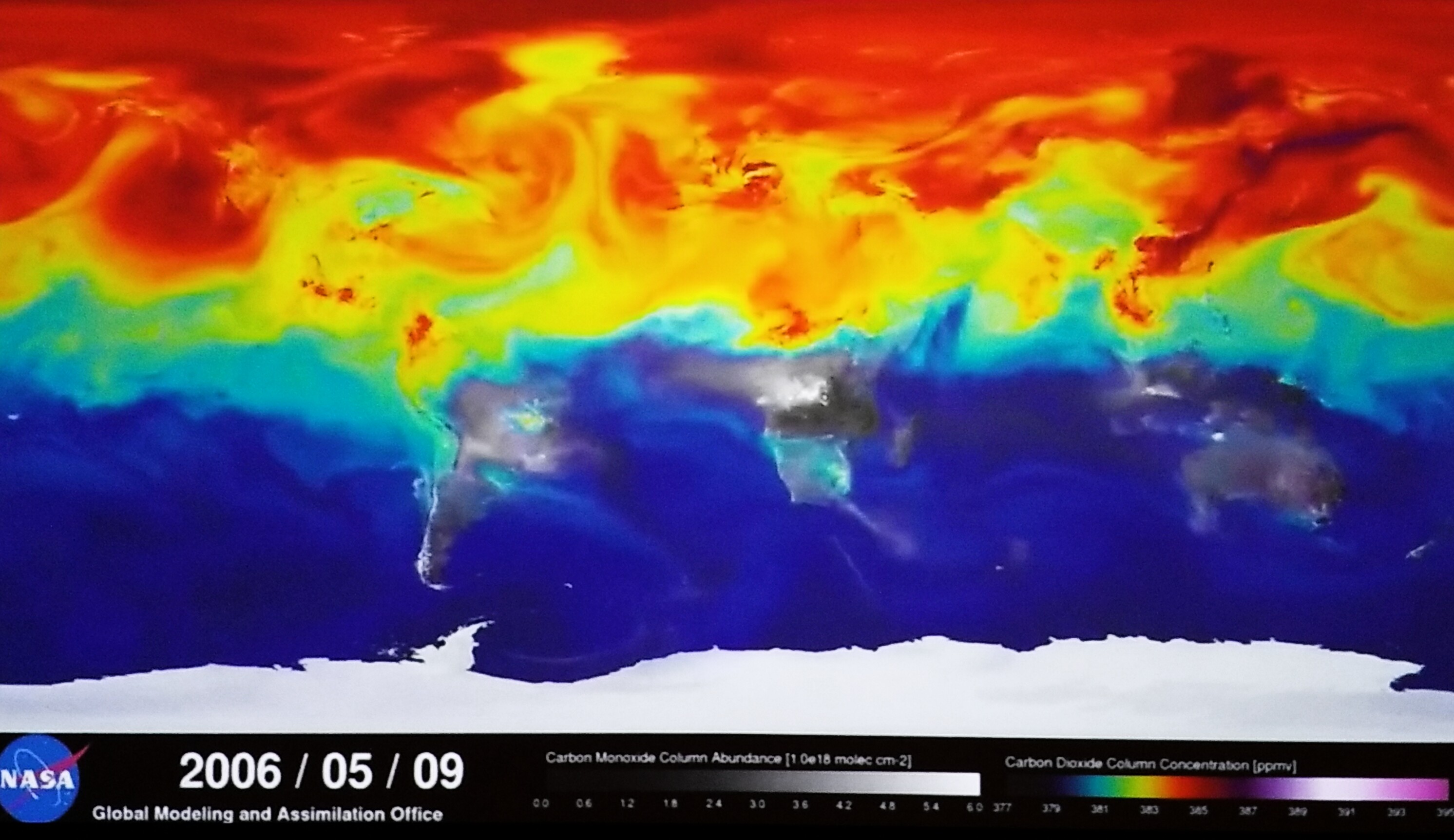
Speaker: Tom Crowther, Professor of Global ecosystem Ecology at ETH Zürich
Jack welcomes the audience back from lunch. We are committed to working with conservation and moving forward. He introduces the next speaker, Tom Crowther from the Crowther Lab at ETH Zürich takes us on a digital presentation with a call to action to the GIS community, and the world, to learn and understand the importance of biodiversity. Global ecological restoration is the key to fight the impacts of climate change, biodiversity loss, and rural poverty.
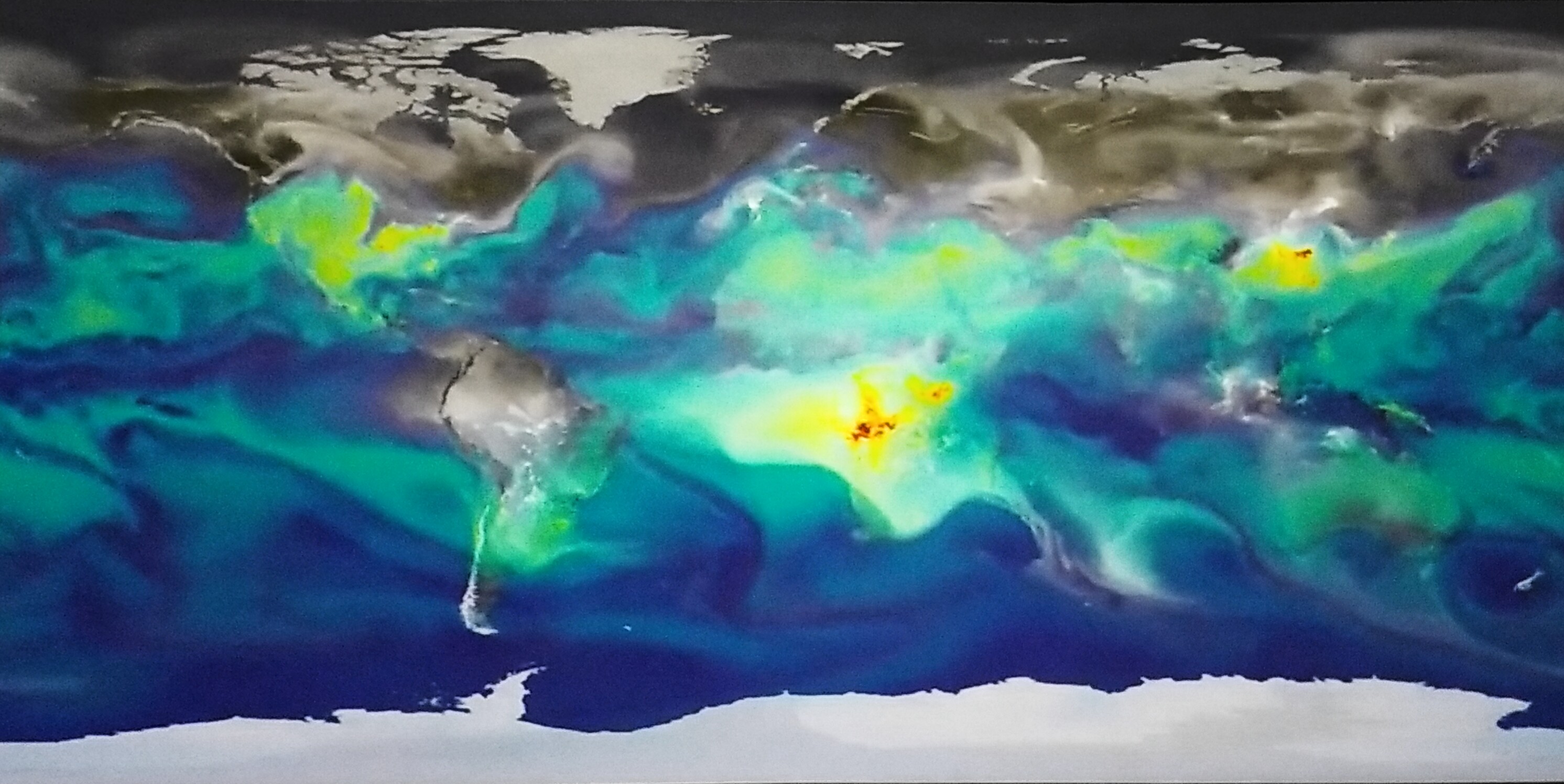 The map to the right shows the amount of carbon dioxide in the atmosphere during the winter months (in red) in comparison to the Spring when trees are in full bloom (in blue).
The map to the right shows the amount of carbon dioxide in the atmosphere during the winter months (in red) in comparison to the Spring when trees are in full bloom (in blue).
It is estimated that only 3% of the trees in the world make it to maturity. What we need to know is which soils these trees need to grow and survive.
Below the canopy's surface, below the trees and deeper down into the soil, there is a whole ecosystem that helps grow trees, grow vegetation, and understanding this ecosystem allows us to understand these ecosystems effectively we have room for another 1.2 trillion trees.
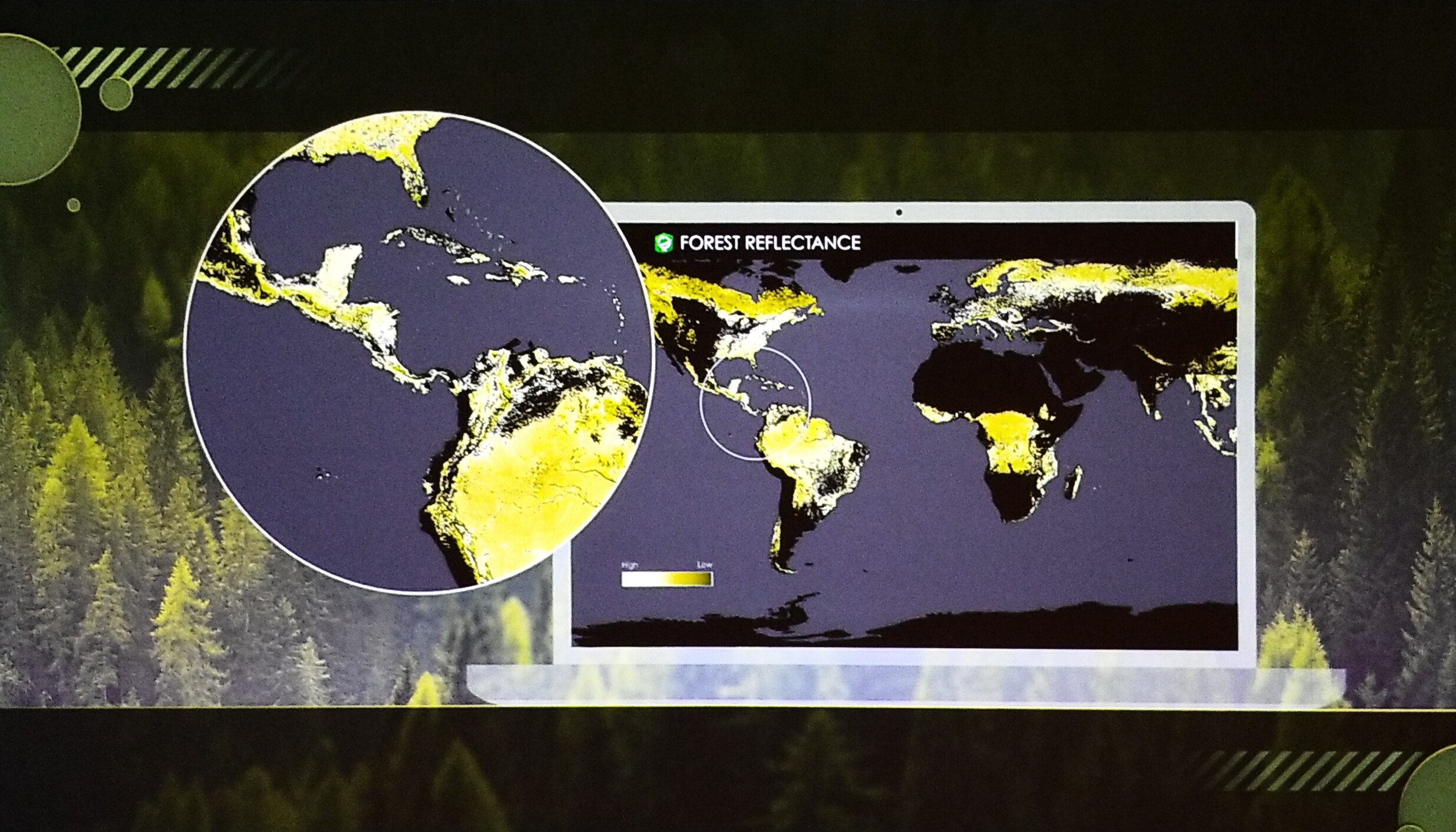
For decades, soil scientists have been taking samples of the species in the soil. We know so little about this ecosystem, but what we learned is that the soil compositions are home to billions of nematodes.
We did our research to find out why some areas have more nematodes, and others have less.
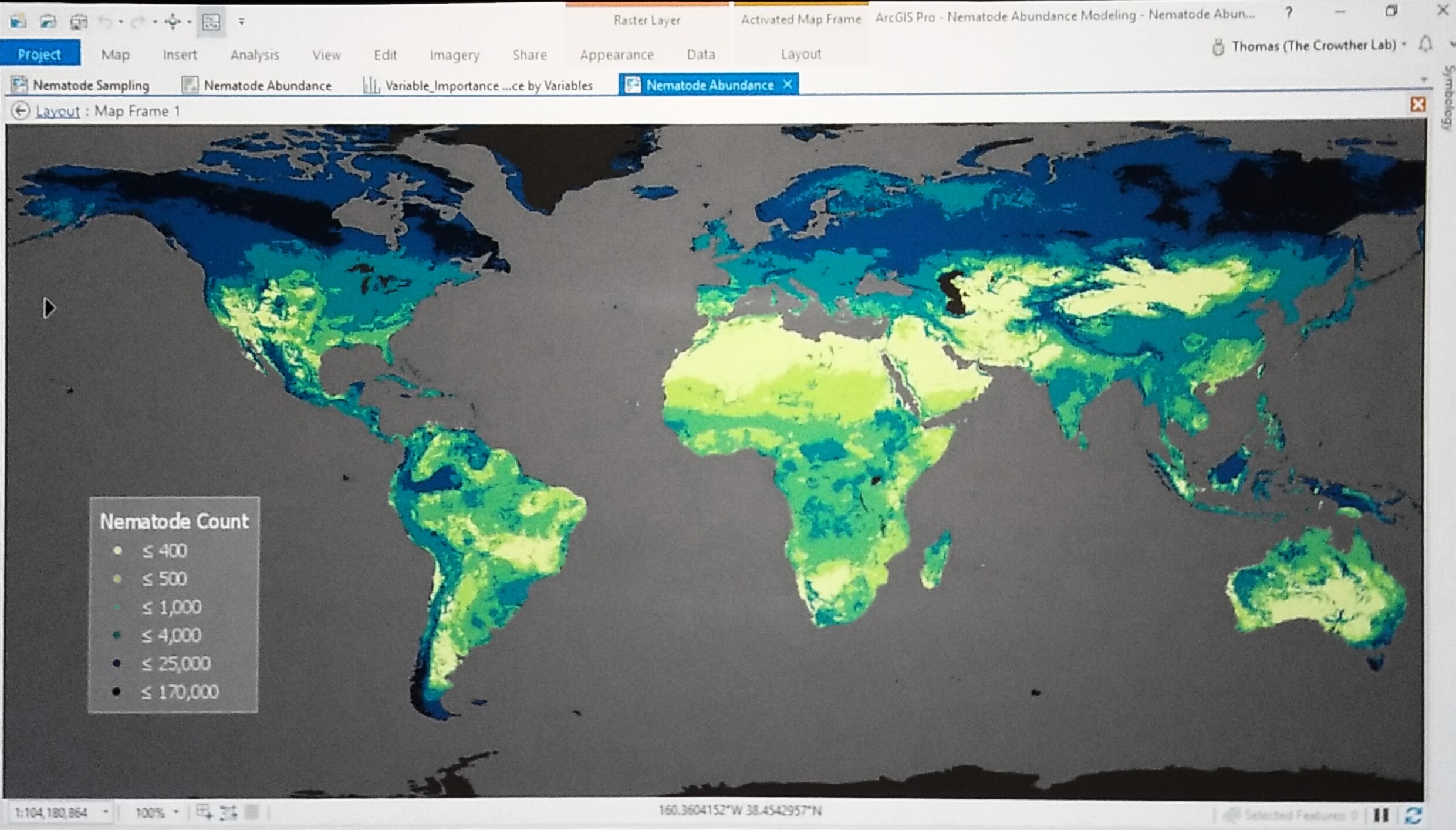
With a new perspective on the diversity of the soil samples, we now know that planting a diversity of tree species has a positive impact compared to planting only the single and fastest growing tree species.
Jack chats with Tom briefly, "As a landscape architect, I always viewed the world as my garden." He thanks Tom for being here.
2:15 p.m. - The Trillion Tree Campaign
Plant-for-the-Planet Initiative
Speaker: Felix Finkbeiner
Opening with a video of Felix Finkbeiner's inspiring words about the climate crisis.
Wangari Maathai (1940-2011), the founder of the Green Belt Movement, started the first movement inspiring the Trillion Tree Campaign and Felix was inspired by her movement.
He encouraged his fellow students to go out into the world and plant trees. He began Plant for the Planet in schools after inspiring his fellow students to plant a tree. And over time, students speaking up for the urgent problem of the climate crisis.
Today, more than 15 billion trees have been planted across the world as the movement spreads and support continues to grow.
Where do we go from here? How many trees exist in the world? And how many trees can we plant?
He asked lots of scientists and no one had an answer until he met with Tom Crowthers. He relayed that we have 3 trillion trees in the world and can still plant 1.2 trillion more.
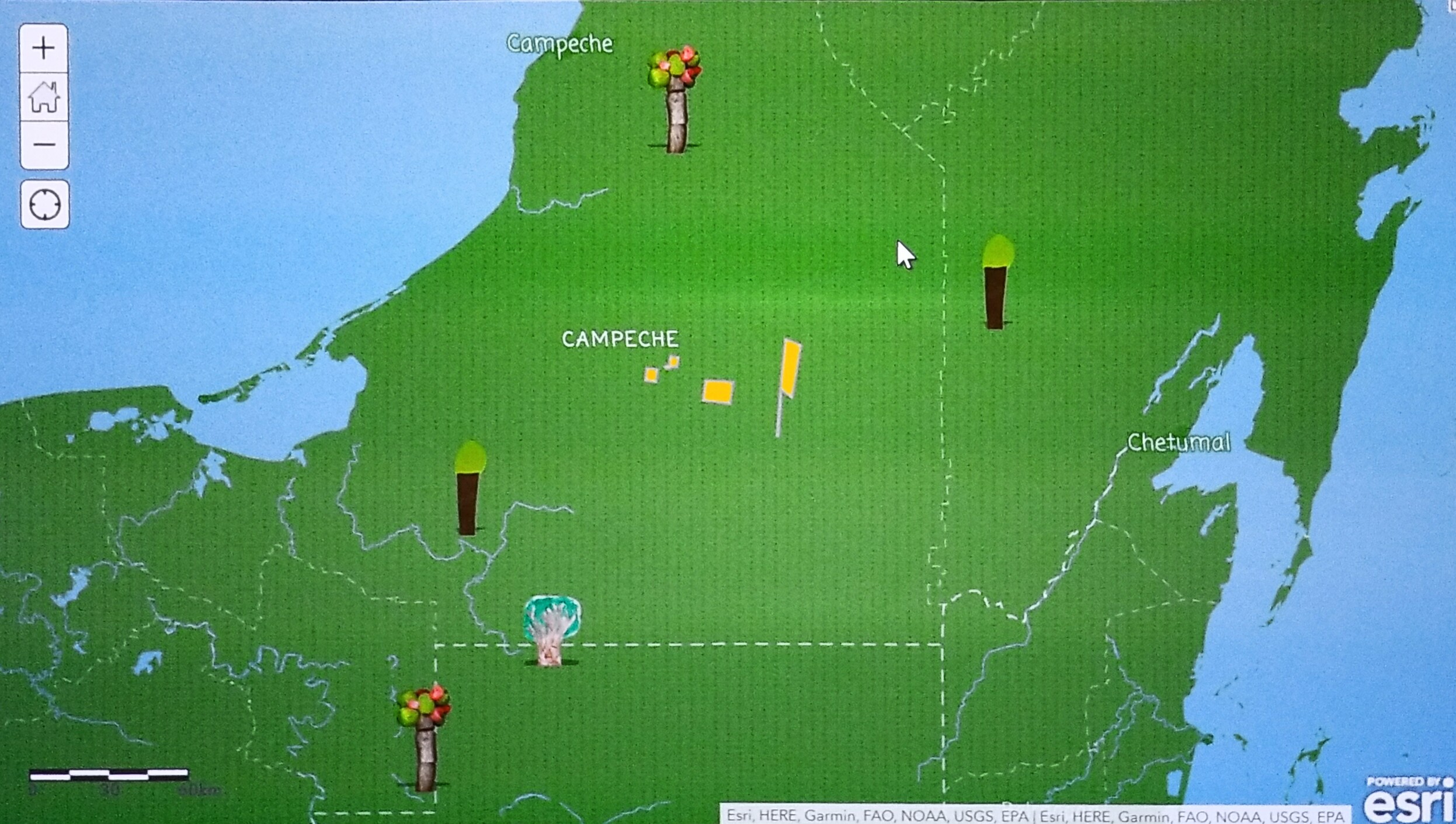
When he visited the Yucatan Peninsula to find out why so much of the forest was disappearing. Today, they employ 100 employees that plant 6,000 trees a day at a cost of just 1 Euro a year to plant the trees. Many of the trees planted are funded by companies that want to be carbon neutral. May be able to plant 100-million trees in Mexico by 2020.
We want to make it as easy and as fun as possible for anyone to plant trees or get involved with planting trees. They created an app that is live today. Trilliontreecampaign.org.
 With this app, you can record the trees you plant and if you can't plant trees, you can donate for the cause. You can track other countries to see how many trees they are planting. You can see what others are doing and follow them as well as gift them a tree to help them reach their target goal for trees.
With this app, you can record the trees you plant and if you can't plant trees, you can donate for the cause. You can track other countries to see how many trees they are planting. You can see what others are doing and follow them as well as gift them a tree to help them reach their target goal for trees.
Written by Matt Ball
When Felix Finkbeiner was nine years old his teacher asked him to give a presentation about climate change. He learned of Wangari Maathai who planted a million trees and urged his class to plant trees. Other students loved the idea, and they soon planted their first tree. An early website was created with a simple comparison of what school planted the most trees. Soon schools competed and they achieved the goal of a million trees planted in Germany, and scaled it to other countries. Today, there are 15Billion trees planted.
When we plant TREES we plant the seeds of #peace and seeds of #hope.
- Wangari Maathai
We had added questions. How many trees are there in the world? Scientists couldn’t answer, until we met Tom Crowther who started a three-year research project. He came back with the answers that there are three trillions trees exist and we have room for a trillion more.
Plant-for-the-Planet now has taken charge of 22,000 hectares, and employ 100 people planting trees in the Yucatan Peninsula in Mexico. People have said that paying for a trillion trees isn’t possible. However, Plant-for-the-Planet has reduced the cost of planting each tree to just 1 Euro per planted tree.
To reach the goal of reaching a trillion trees will require much more. To make it easier to plant trees we created a simple app (using ArcGIS) that goes live today. My personal goal is to plant 1000 trees. If I’m planting trees I can register my trees, their species and location.
It starts today with the Yucatan Reforestation project and will grow to other restoration projects. The app lets us see the 3 trillion trees and where more than a trillion can be planted. A leaderboard helps to promote those that are planting the most.
Jack Dangermond of Esri has pledged to make the conference carbon neutral by taking the data on where people have traveled from and calculating the offset. The calculation amounts to 60,000 trees.
2:33 p.m. - Our Towns – A 100,000-Mile Journey into the Heart of America
Speakers: James and Deborah Fallows
What's next for the planet and many of our societies brings lots of challenges. We are all responsible for the challenges. We want to leave you feeling inspired by what's next when you leave here. They share a story map of Our TOwns: Renewal from the Ground Up.
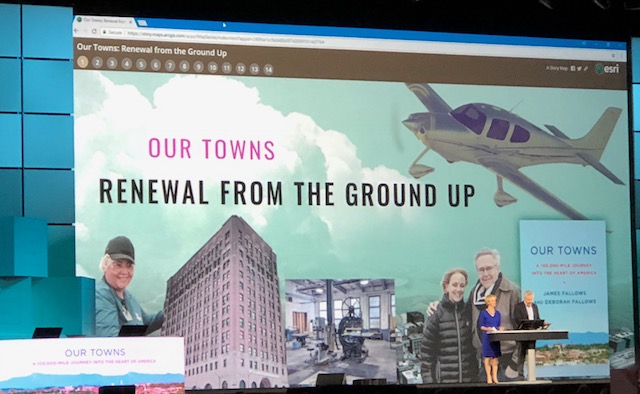
 We see shifts in blue-collar to white-collar manufacturing jobs, poverty shifts, drug poisoning from opioids. What surprised them is the increase in advanced higher-learning across the U.S. and the role that community colleges are providing new opportunities for those seeking to advance their education or careers. And last slide James shares is how the refugee arrivals are the U.S. is declining.
We see shifts in blue-collar to white-collar manufacturing jobs, poverty shifts, drug poisoning from opioids. What surprised them is the increase in advanced higher-learning across the U.S. and the role that community colleges are providing new opportunities for those seeking to advance their education or careers. And last slide James shares is how the refugee arrivals are the U.S. is declining.
Deborah follows James with a description of the changes in Greenville, South Carolina as the city improves education, jobs, partnerships, infrastructure.
She continues to share a story of poverty in Erie, Pennsylvania. In a collaborative partnership, the town of Erie, Pennsylvania is growing, prospering, and increasing in tourism, cultures, businesses, and growth in the city.
James shares the history of the NRA as not gun activists, but as people who believed in reforming their cities, progressive in change for the better. He leaves with a message from the NRA motto, "We do our part" as a message to all to do our part to change the world.
Written by Matt Ball
Our Towns–A 100,000-Mile Journey into the Heart of America
For the last five years, James and Deborah Fallows have been traveling across America in a single-engine prop plane visiting dozens of towns and interviewing hundreds of civic leaders, entrepreneurs, city workers, educators, students, librarians, immigrants, artists, environmentalists, and craft brewers. The focus of this work is decidedly progressive in that it focuses on those that are forging economic and social progress in their localities.
The project kicked off five years ago on the Esri UC stage, with a discussion of what we could discover about our country. The book often compares divergent cities, such as Greenville, South Carolina versus Burlington, Vermont. The focus is on cities that have momentum.
Geographers that deploy the science of geography with Esri software would call this approach field research— "the systematic observation and collection of otherwise unavailable (primary) data." They set out to document trends and uncover the stories of progress.
They came away with some overriding ideas about what works. Aspects of the educational system, specifically the role of community colleges to help those looking for new opportunities, stood out as a positive force. Refugee arrivals across the country also stood out. Many up-and-coming cities have specialized in accommodating first-generation immigrants.
Greenville, South Carolina surprised them, with its transformation from the textile trade and the resurgence of the downtown. It’s now an economically vibrant city with advanced manufacturing for BMW, Michelin, and GE. The local schools are celebrated with an elementary school focused on engineering. The falls of the Reedy River has been liberated from a highway overpass and have become a favorite gathering place.
Erie, Pennsylvania was a manufacturing hub, and has seen decline including the demise of the GE locomotive plant and the loss of 10,000 jobs. A group of residents rewrote the down-and-out story, and now there are tech startups and startups. The downtown has added a number of amenities, including a number of craft breweries. The population is 10 percent refugees.
We have a similar inspiration and a charge to inspire what’s next.
2:53 p.m. Making a Difference Award
Jack presents the Making-A-Difference award to two teachers who have worked together for the last 8-years in Boyle Heights, California to inspire students to learn GIS, create projects that map out stories of their communities.
Congratulations to two amazing educators, Alice Im and Mariana Ramirez!
Students share the results of their findings at Esri. These students continue to share their results to advocate for their communities, for improvement and change, changing the lives of the students and their community.
Jack shares a video to explain why he is giving the teachers an award today. Students
 After the video, the audience gives a roar of cheers. With tears of joy, both Alice and Mariana share their thanks for the partnership with Jack and Esri and what they desire.
After the video, the audience gives a roar of cheers. With tears of joy, both Alice and Mariana share their thanks for the partnership with Jack and Esri and what they desire.
Jack thanks both for being here and the audience gives them a standing ovation. Jack asks them to return to the stage once more.
3:05 p.m. Evolving Ourselves - Redesigning the Future of Humanity
Keynote Speaker, Juan Enriquez, Managing Director at Excel Venture Management
The language of the world is changing. It began as hieroglyphics and evolved over centuries as cultures learned to write and create alphabets. Today, our alphabet is continuing to evolve as the world of digital code expands our alphabet and our ability to communicate through 1s and 0s.
Small changes in code have an impact on the message whether it is digital code or DNA.
"All life is Code."
“If life is code, we can read code, copy code, edit code—and it will change the world.” ~ Juan Enriquez
The code of Life Sciences is what is pushing mapping, pushing AI, pushing high-end mapping. Flipping the logic of Charles Darwin's theory of evolution driven by humans becomes an un-natural selection. We are deciding what lives and dies, what is non-random mutation.
"We are entering an era of intelligent design."
As humans, we can make programmable life forms, can make almost anything. We are beginning to integrate technology with creating life. We are getting to a point in time where we can take the code in each of ourselves and make copies of ourselves. We already do this when our cells make new teeth, grow bones, new skin. And as we continue to learn how to make code, we can make anything, except for the brain. 
The cutting edge of map-making will be when we can map the human brain. Dr. Mary Lou Jepson, inspired by her own brain tumor, decided to learn just how to map the brain and with the support and vision of Openwater, she is currently in the process of building a non-invasive lab size prototype for mapping the brain.
3:35 p.m. Closing
Jack thanks the audience and invites everyone to the Map Gallery.
You must be a registered user to add a comment. If you've already registered, sign in. Otherwise, register and sign in.
-
Esri UC Behind-the-Scenes
8 -
UC 2018 Plenary and Updates
7 -
UC Events
4 -
User Conference 2016
9 -
User Conference 2017
5 -
User Conference 2018
13 -
User Conference 2019
2 -
User Conference 2020
7 -
User Conference 2021
13 -
User Conference 2022
5 -
User Conference 2023
2 -
User Conference 2024
2 -
User Conference 2025
9